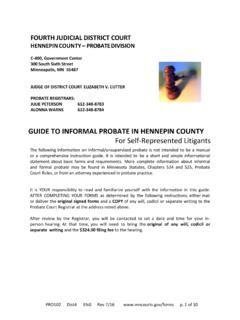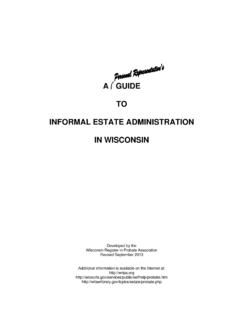Transcription of PEOPLE LIVING IN INFORMAL SETTLEMENTS
1 PEOPLE LIVING IN INFORMAL SETTLEMENTSGENERAL CONSIDERATIONSI ssuesPerinatal diseasesDiarrhoeal diseasesPhysical injuriesType ofindicatorExposure (distal/state)Can also be used as a measure of action in relation to housing urbanization and inadequate capability to cope with the housing needsof PEOPLE in urban areas have contributed to the development of informalsettlements. LIVING in these SETTLEMENTS often poses significant health , food storage facilities and drinking water quality are often poor,with the result that inhabitants are exposed to a wide range of pathogens andhouses may act as breeding grounds for insect vectors. Cooking and heatingfacilities are often basic, with the consequence that levels of excessiveexposures to indoor pollution may occur.
2 Access to health and other servicesmay be limited; overcrowding can contribute to stress, violence andincreased problems of drugs and other social problems. Together, thesepose special risks to children both during the prenatal period and after indicator provides a general measure of these risks. Issues inindicatordesignSevere problems exist both in defining ' INFORMAL SETTLEMENTS ' and in obtainingreliable data on the number of PEOPLE who live within them. The definition of INFORMAL SETTLEMENTS is context-specific. Various definitionshave thus been proposed, but that suggested by the UN Habitat Programmeis probably the most widely applicable. This defines INFORMAL SETTLEMENTS as:i) residential areas where a group of housing units has been constructed onland to which the occupants have no legal claim, or which they occupyillegally; ii) unplanned SETTLEMENTS and areas where housing is not incompliance with current planning and building regulations (unauthorizedhousing).
3 Many other terms and definitions have also been devised for INFORMAL humansettlements, for example: unplanned SETTLEMENTS , squatter SETTLEMENTS ,marginal SETTLEMENTS , unconventional dwellings, non-permanent structures,inadequate housing, slums, housing in compliance etc. Unconventionaldwellings are commonly defined by the number of housing units occupied byhouseholds, but considered inappropriate to human habitation. Housing incompliance is used as a Human SETTLEMENTS Indicator by the UN HabitatProgramme and is defined as the percentage of the total housing stock inurban areas which is in compliance with current regulations (authorizedhousing). Housing may also be categorized by its type or permanence ( , semi-permanent, non-permanent), although definitions of thesecategories vary widely from country to occur in measuring the extent or defining the boundaries of suchsettlements.
4 By definition, officially recognized boundaries to thesesettlements rarely exist, and the SETTLEMENTS themselves often merge almostimperceptibly into formal areas of housing, industrial or rural areas. Use ofremotely sensed data ( aerial photography or high resolution satellitedata) may be useful in this context. Similar difficulties occur in obtaining data on the numbers of PEOPLE who livewithin these SETTLEMENTS . They are often not covered by formal censuses,and many of the PEOPLE LIVING in the SETTLEMENTS may not be registered orofficially recognized. Most population data are therefore estimates, and assuch are subject to considerable uncertainties. SPECIFICATIOND efinition Percentage of the population (or number of PEOPLE ) LIVING in andconceptsInformal SETTLEMENTS : based on the UN Habitat Programme definition, theseare defined as: i) residential areas where a group of housing units has beenconstructed on land to which the occupants have no legal claim, or whichthey occupy illegally; ii) unplanned SETTLEMENTS and areas where housing isnot in compliance with current planning and building regulations(unauthorized housing).
5 Unauthorized housing: excludes units where land titles, leases oroccupancy permits have been granted (UN 1996).It should be noted that INFORMAL SETTLEMENTS do NOT cover the needsNumber of PEOPLE LIVING in INFORMAL sources,availability andqualityInformation on the number of PEOPLE LIVING in INFORMAL SETTLEMENTS is oftenlimited, since inhabitants are often only inadequately covered by formalcensuses: census data may therefore not provide a clear separation of thoseliving in INFORMAL SETTLEMENTS . Where suitable census data do not exist,special surveys may be necessary. Data on the total population should be available from national censuses andshould be broadly of spatialaggregationMunicipality, district etcAveragingperiodAnnual to decadalComputationThe indicator is computed as:100 * Pinf / Ptot)where Pinf is the number of PEOPLE LIVING in INFORMAL SETTLEMENTS and Ptot isthe total number ofmeasurementPercentage (or number)WorkedexampleAssume that a total of 3 600 PEOPLE are counted in INFORMAL SETTLEMENTS , froma total city population of 26 900.
6 In this case, the value of the indicator willbe:100 * (3 600 / 26 900) = indicator provides a relatively straightforward measure of the quality ofhousing, and thus of the risks to children's health. A large percentage ofpeople LIVING in INFORMAL SETTLEMENTS can be taken to imply an increased riskto children's health; a low percentage implies a reduced , the relationship between the number of PEOPLE LIVING ininformal SETTLEMENTS and environmental health is not always simple. Inparticular, those LIVING in formal SETTLEMENTS are not necessarily betterprovided for ( the homeless or PEOPLE LIVING in crowded or unsafehousing). Problems of data accuracy also mean that the indicator should beinterpreted with care, especially where comparisons are being made betweendifferent surveys.
7 Variations andalternativesThe indicator proposed above is non-specific, in that it relates to the totalpopulation. In practice, variations on this indicator are likely to be useful,aimed at more specific age groups. For perinatal diseases, the target groupshould be women of childbearing age (15-49 years); for respiratory illness the0-5 year age group is likely to be the most relevant; for physical injuries allchildren (0-14 years) should be indicator can also be defined on the basis of different classifications ofinformal SETTLEMENTS (or other, similar concepts). Where suitable data on population are not available, the indicator mightalternatively be measured as the area ( km2) of INFORMAL SETTLEMENTS .
8 Thismay be estimated from aerial photographs. It is liable to understate the scaleof the problem, however, since it makes no allowance for population density,which is often higher in INFORMAL SETTLEMENTS than in formal Environmental health indicators: framework and methodologies Population in INFORMAL settlementsUN Indicators of sustainable development Area and population of urban formal and INFORMAL settlementsUsefulreferencesUN 1996 Indicators of sustainable development. Framework andmethodologies. New York: United (Habitat) and the World Bank 1993 The housing indicatorsprogramme. Report and the Executive Director (Volume I). Nairobi: UnitedNations Centre for Human (Habitat) 1995 Monitoring the shelter sector.
9 Housing Indicatorsreview. Nairobi: United Nations Centre for Human (Habitat) 1995 Monitoring human SETTLEMENTS , abridged Programme. Nairobi: United Nations Centre for Urban Indicators Programme website: 1999 Environmental health indicators: framework and : WHO. (Available )

















